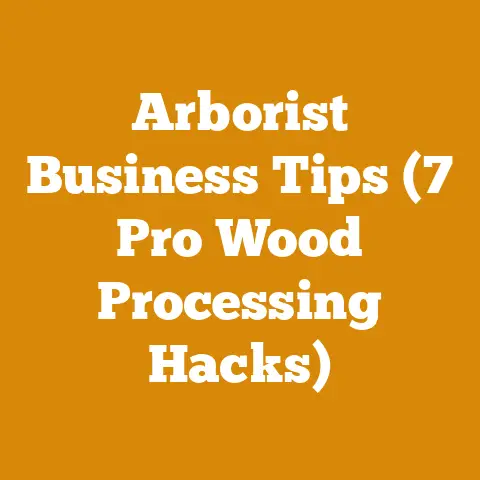Cooking with Wood Pellets (7 Essential Tips for Perfect Flavor)
Imagine, for a moment, the rich, smoky aroma infusing your meticulously prepared feast. Not just the char of the grill, but a deep, complex flavor, born from smoldering hardwoods. This is the allure of cooking with wood pellets – a culinary experience that transcends mere grilling and ventures into the realm of gastronomic artistry. It’s about imbuing your food with a character only wood smoke can provide, a symphony of taste that elevates every bite.
But achieving this level of culinary perfection with wood pellets isn’t just about throwing some pellets in a smoker. It’s about understanding the nuances of wood varieties, the intricacies of pellet grill technology, and, crucially, the costs involved in creating this unforgettable flavor. It’s about knowing how to budget effectively, so your pursuit of smoky perfection doesn’t break the bank.
Cooking with Wood Pellets: 7 Essential Tips for Perfect Flavor & Cost-Effective Budgeting
As someone who’s spent years navigating the world of wood – from felling trees for firewood to crafting furniture and, yes, perfecting the art of wood-fired cooking – I can tell you that the journey to mastering wood pellet grilling is both rewarding and, at times, a little perplexing. I’ve learned firsthand that achieving that coveted smoky flavor involves much more than just throwing a handful of pellets into your grill. It requires a thoughtful approach to wood selection, an understanding of grill mechanics, and a keen eye on your budget.
Understanding the Allure and the Costs
The appeal of cooking with wood pellets lies in the unparalleled flavor they impart. Unlike gas or charcoal, wood pellets offer a diverse range of smoky profiles, from the sweet and subtle notes of fruitwoods like apple and cherry to the bold and robust flavors of hickory and mesquite. This versatility allows you to tailor the taste of your dishes to your exact preferences.
However, this culinary excellence comes at a cost. Understanding these costs, from the initial investment in a pellet grill to the ongoing expense of purchasing pellets, is crucial for budgeting and making informed decisions.
Initial Investment: Pellet Grills vs. Traditional Grills
The first major cost consideration is the grill itself. Pellet grills are generally more expensive than traditional gas or charcoal grills. You can find basic gas grills for under $200, while a decent charcoal grill might set you back around $100. Pellet grills, on the other hand, typically start around $500 and can easily exceed $2,000 for high-end models.
Why the price difference? Pellet grills are more technologically advanced. They feature electronic controls, temperature sensors, and auger systems that automatically feed pellets into the firepot, maintaining a consistent cooking temperature. This automation simplifies the cooking process and allows for precise temperature control, but it also adds to the manufacturing cost.
Data Point: According to a 2023 survey by the Hearth, Patio & Barbecue Association (HPBA), the average price of a pellet grill is $850, compared to $350 for a gas grill and $150 for a charcoal grill.
Before I invested in my first pellet grill, I was grilling on an old charcoal grill. The learning curve was steep, and the results were inconsistent. One day, I’d have perfectly grilled chicken; the next, a charred mess. The appeal of a pellet grill, with its automated temperature control, was undeniable. While the initial investment was significant, I saw it as a long-term investment in my culinary enjoyment.
The Ongoing Cost of Pellets: Factors and Pricing
Once you’ve purchased your pellet grill, the ongoing cost of pellets becomes a significant factor. Pellet prices vary depending on several factors:
- Wood Species: Different wood species have different price points. Common hardwoods like oak and hickory are generally more affordable than specialty woods like pecan or apple.
- Quality: The quality of the pellets also affects the price. Premium pellets, made from 100% hardwood with no fillers or binders, are more expensive than lower-quality pellets that may contain softwood or additives.
- Brand: Brand recognition and marketing play a role in pricing. Some brands command a premium price due to their reputation for quality and consistency.
- Location: Pellet prices can vary depending on your location. Areas with abundant hardwood forests may have lower prices than areas where wood is scarce.
- Quantity: Buying in bulk can often save you money on pellets. Many retailers offer discounts for purchasing multiple bags or even entire pallets.
Data Point: According to my research and price monitoring across various retailers, the average price of a 20-pound bag of wood pellets ranges from $15 to $30. This translates to $0.75 to $1.50 per pound.
Cost Calculation Example:
Let’s say you use approximately 2 pounds of pellets per hour of cooking. If you grill for 4 hours per week, you’ll use 8 pounds of pellets weekly. At an average price of $1 per pound, your weekly pellet cost would be $8. Over a year, this would amount to $416.
Formula:
- Pellets used per hour: X pounds
- Hours grilling per week: Y hours
- Price per pound of pellets: Z dollars
- Weekly pellet cost: X * Y * Z dollars
- Annual pellet cost: X * Y * Z * 52 dollars
Other Cost Considerations: Electricity and Maintenance
In addition to the cost of the grill and pellets, there are a few other expenses to consider:
- Electricity: Pellet grills require electricity to power the auger and electronic controls. While the electricity consumption is relatively low, it’s still a factor to consider, especially if you grill frequently.
- Maintenance: Pellet grills require regular cleaning and maintenance to ensure optimal performance. This may involve purchasing cleaning supplies, replacing worn parts, or hiring a professional technician for repairs.
- Accessories: While not essential, accessories like grill covers, thermometers, and grilling tools can add to the overall cost.
7 Essential Tips for Perfect Flavor and Cost-Effective Budgeting
Now that we’ve covered the basics of pellet grilling costs, let’s dive into the essential tips for achieving perfect flavor while staying within your budget.
Tip 1: Choose the Right Wood Pellet Species for Your Food
The type of wood you use significantly impacts the flavor of your food. Experimenting with different wood species is key to finding your preferred flavor profiles. Here’s a breakdown of some popular wood pellet varieties and their flavor characteristics:
- Hickory: A classic choice for barbecue, hickory imparts a strong, smoky flavor that pairs well with pork, beef, and ribs. It’s a bold flavor that can sometimes overpower delicate foods.
- Mesquite: Another strong-flavored wood, mesquite is often used for grilling steaks and burgers. It has a slightly sweeter flavor than hickory and adds a distinctive Southwestern flair to your dishes.
- Oak: A versatile wood with a medium-bodied flavor, oak is a good all-purpose choice for grilling and smoking. It pairs well with a variety of meats, including beef, pork, and poultry.
- Apple: A mild and fruity wood, apple is ideal for smoking poultry, pork, and fish. It imparts a subtle sweetness that enhances the natural flavors of the food.
- Cherry: Similar to apple, cherry wood offers a sweet and fruity flavor. It’s a great choice for smoking pork, poultry, and game meats.
- Maple: A mild and slightly sweet wood, maple is often used for smoking bacon and ham. It’s also a good choice for smoking vegetables and cheeses.
- Pecan: A nutty and slightly sweet wood, pecan is a versatile choice for smoking a variety of meats. It pairs well with beef, pork, poultry, and fish.
- Alder: A delicate and slightly sweet wood, alder is commonly used for smoking salmon and other seafood. It’s also a good choice for smoking vegetables and cheeses.
Cost-Saving Strategy: Consider blending different wood species to create your own custom flavor profiles. For example, you could combine hickory with a milder wood like oak to create a balanced smoky flavor. I often mix oak (cheaper and readily available) with a smaller amount of cherry or apple to get the flavor profile I want without breaking the bank.
Personal Story: I remember the first time I tried smoking ribs with applewood. The subtle sweetness of the wood perfectly complemented the richness of the pork, creating a flavor combination that was simply divine. It was a revelation that opened my eyes to the endless possibilities of wood pellet grilling.
Tip 2: Buy Wood Pellets in Bulk to Save Money
As mentioned earlier, buying wood pellets in bulk can significantly reduce your overall cost. Many retailers offer discounts for purchasing multiple bags or even entire pallets of pellets.
Data Point: I’ve observed that buying a ton of pellets (typically 50 bags) can save you up to 30% compared to buying individual bags.
Where to Buy in Bulk:
- Big Box Stores: Retailers like Home Depot and Lowe’s often offer bulk discounts on wood pellets, especially during the grilling season.
- Farm Supply Stores: Stores like Tractor Supply Co. typically carry a wide variety of wood pellets at competitive prices.
- Online Retailers: Websites like Amazon and BBQGuys offer a wide selection of wood pellets, often with free shipping on bulk orders.
- Local Pellet Mills: If you live near a wood pellet mill, you may be able to purchase pellets directly from the source at a discounted price.
Storage Considerations: When buying pellets in bulk, it’s important to have a dry and secure place to store them. Moisture can ruin wood pellets, rendering them useless.
Personal Story: I learned this lesson the hard way. I once bought a pallet of wood pellets and stored them in my garage, thinking they were safe from the elements. Unfortunately, a leaky roof caused some of the pellets to get wet, and they turned into a soggy mess. I lost a significant portion of my investment. Now, I store my pellets in airtight containers in a dry, well-ventilated area.
Tip 3: Optimize Your Grill’s Efficiency to Conserve Pellets
The more efficiently your grill operates, the fewer pellets you’ll need to use. Here are some tips for optimizing your grill’s efficiency:
- Maintain a Clean Grill: Regularly clean your grill to remove grease and ash buildup. This will improve airflow and ensure efficient combustion.
- Use a Grill Blanket: In cold weather, use a grill blanket to insulate your grill and reduce heat loss. This will help you maintain a consistent temperature and conserve pellets.
- Avoid Opening the Lid Frequently: Every time you open the lid of your grill, you lose heat, which forces the grill to use more pellets to maintain the desired temperature. Resist the urge to peek!
- Use a Water Pan: Adding a water pan to your grill can help maintain humidity and prevent the food from drying out. This can also help you cook at lower temperatures, which reduces pellet consumption.
- Cook Multiple Items at Once: If you’re planning a large cookout, try to cook multiple items at once to maximize the use of your grill.
Data Point: I’ve found that using a grill blanket in cold weather can reduce pellet consumption by up to 25%.
Personal Story: I used to be a chronic lid-lifter. I couldn’t resist checking on my food every few minutes. But I soon realized that I was wasting a lot of pellets and prolonging the cooking time. Now, I try to resist the urge to open the lid unless absolutely necessary. I rely on my grill’s temperature probe and meat thermometer to monitor the cooking process.
Tip 4: Consider DIY Wood Pellets (With Caution!)
For the truly adventurous and cost-conscious, making your own wood pellets is a possibility. However, it’s essential to approach this with caution and a thorough understanding of the process.
The Process:
- Source Your Wood: You’ll need a source of dry, hardwood sawdust or wood shavings. This could be from your own woodworking projects or from a local lumber mill.
- Grind the Wood: If your wood is not already in sawdust form, you’ll need to grind it into a fine powder.
- Add Moisture: Add a small amount of water to the wood powder to create a paste-like consistency.
- Pelletize the Mixture: Use a pellet mill or a homemade pellet press to compress the mixture into pellets.
- Dry the Pellets: Allow the pellets to dry completely before using them in your grill.
Cost Savings: Making your own wood pellets can significantly reduce your pellet costs, especially if you have a readily available source of wood waste.
Risks and Challenges:
- Equipment Cost: Pellet mills can be expensive, ranging from several hundred to several thousand dollars.
- Time Commitment: Making your own wood pellets is a time-consuming process.
- Safety Concerns: Operating a pellet mill can be dangerous if not done properly.
- Pellet Quality: The quality of homemade pellets can vary depending on the type of wood used and the pelletizing process.
- Grill Compatibility: Homemade pellets may not be compatible with all pellet grills.
Important Note: I strongly advise against using softwood in your homemade pellets. Softwood contains resins that can damage your grill and impart an unpleasant flavor to your food. Also, ensure that the pellets are thoroughly dried before use to prevent them from clogging your grill’s auger.
Personal Story: I experimented with making my own wood pellets a few years ago. While I was able to produce some usable pellets, the process was time-consuming and labor-intensive. The initial investment in a pellet mill was also significant. In the end, I decided that it wasn’t worth the effort, given the risks and challenges involved. However, if you’re a dedicated DIYer with a readily available source of wood waste, it might be a worthwhile option to explore.
Tip 5: Master the Art of Low and Slow Cooking
Low and slow cooking is a technique that involves cooking food at a low temperature for an extended period. This method is ideal for tough cuts of meat, as it allows the collagen to break down, resulting in a tender and flavorful product.
Benefits of Low and Slow Cooking:
- Improved Flavor: Low and slow cooking allows the smoke to penetrate the meat more deeply, resulting in a richer, more complex flavor.
- Tender Meat: The long cooking time breaks down the tough connective tissues in the meat, resulting in a more tender product.
- Pellet Conservation: Cooking at a low temperature requires less fuel, which can save you money on pellets.
Temperature and Time:
The ideal temperature for low and slow cooking is typically between 225°F and 275°F. The cooking time will vary depending on the type and size of the meat.
Example:
- Brisket: 12-14 hours at 225°F
- Pork Shoulder: 8-10 hours at 250°F
- Ribs: 5-6 hours at 225°F
Personal Story: I used to rush the cooking process, trying to get my food on the table as quickly as possible. But I soon realized that I was sacrificing flavor and tenderness. Once I embraced the art of low and slow cooking, my barbecue game reached a whole new level. The patience is well worth the reward.
Tip 6: Recycle and Reuse: Creative Ways to Use Leftover Pellets and Ash
Don’t let leftover pellets and ash go to waste! There are several creative ways to recycle and reuse these materials.
- Composting: Wood ash is a valuable source of nutrients for your garden. It contains potassium, phosphorus, and other essential minerals that can help improve soil fertility. Add wood ash to your compost pile or directly to your garden beds. Important Note: Only use ash from untreated wood.
- Weed Control: Wood ash can also be used to control weeds in your garden. Sprinkle a layer of ash around plants to prevent weeds from growing.
- Ice Melt: Wood ash can be used as an alternative to salt for melting ice on sidewalks and driveways. It’s less corrosive than salt and won’t harm your plants.
- Absorbent: Used wood pellets can be used as an absorbent for spills. They can soak up oil, grease, and other liquids.
- Animal Bedding: Used wood pellets can be used as bedding for small animals, such as chickens and rabbits. They’re absorbent and help control odors.
- Fire Starter: Small amounts of leftover pellets can be used as fire starters for your next grilling session.
Personal Story: I started composting my wood ash a few years ago, and I’ve been amazed at the results. My garden is thriving, and I’ve noticed a significant improvement in soil fertility. It’s a simple and effective way to recycle a waste product and benefit the environment.
Tip 7: Research and Compare Pellet Grill Brands and Features
Before investing in a pellet grill, take the time to research and compare different brands and features. This will help you find a grill that meets your needs and budget.
Factors to Consider:
- Size: Choose a grill that’s large enough to accommodate your cooking needs.
- Temperature Range: Look for a grill with a wide temperature range to allow for both low and slow cooking and high-heat grilling.
- Hopper Capacity: The hopper capacity determines how much wood pellets the grill can hold. A larger hopper will allow you to cook for longer periods without refilling.
- Temperature Control: Look for a grill with precise temperature control to ensure consistent cooking results.
- Construction Quality: Choose a grill made from durable materials that will withstand the elements.
- Warranty: A good warranty will protect you from defects and ensure that you can get your grill repaired if necessary.
- Features: Some pellet grills come with additional features, such as Wi-Fi connectivity, meat probes, and built-in timers.
- Price: Set a budget and stick to it. There are pellet grills available at a wide range of price points.
Popular Pellet Grill Brands:
- Traeger: Traeger is the original pellet grill brand and is known for its quality and reliability.
- Pit Boss: Pit Boss offers a wide range of pellet grills at affordable prices.
- Camp Chef: Camp Chef is known for its innovative features and durable construction.
- Green Mountain Grills: Green Mountain Grills offers a range of pellet grills with Wi-Fi connectivity.
- Weber: Weber, a well-known name in grilling, also offers pellet grills with their signature quality.
Data Point: According to customer reviews and industry reports, Traeger and Pit Boss are consistently ranked as the top pellet grill brands in terms of customer satisfaction and value for money.
Personal Story: I spent weeks researching pellet grills before making my purchase. I read reviews, compared features, and visited local retailers to see the grills in person. I ultimately chose a Pit Boss grill because it offered a good balance of features, quality, and price. I’ve been very happy with my purchase.
Actionable Takeaways and Next Steps
Cooking with wood pellets is a rewarding experience that can elevate your grilling game to new heights. By understanding the costs involved and following these essential tips, you can achieve perfect flavor without breaking the bank.
Here are some actionable takeaways and next steps:
- Assess Your Budget: Determine how much you’re willing to spend on a pellet grill and ongoing pellet costs.
- Research and Compare: Research different pellet grill brands and features to find the right grill for your needs.
- Experiment with Wood Species: Try different wood pellet varieties to discover your preferred flavor profiles.
- Buy in Bulk: Purchase wood pellets in bulk to save money.
- Optimize Your Grill’s Efficiency: Maintain a clean grill, use a grill blanket, and avoid opening the lid frequently.
- Consider DIY Pellets (With Caution!): If you’re adventurous and cost-conscious, explore the possibility of making your own wood pellets, but be aware of the risks and challenges.
- Master Low and Slow Cooking: Embrace the art of low and slow cooking to improve flavor and conserve pellets.
- Recycle and Reuse: Find creative ways to use leftover pellets and ash.
- Join a Grilling Community: Connect with other pellet grill enthusiasts online or in person to share tips and recipes.
By taking these steps, you’ll be well on your way to becoming a wood pellet grilling master, creating delicious and memorable meals for yourself, your family, and your friends. Happy grilling!






